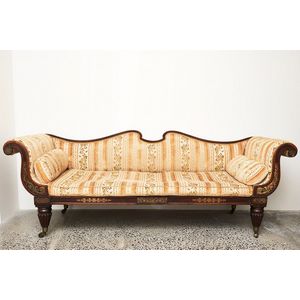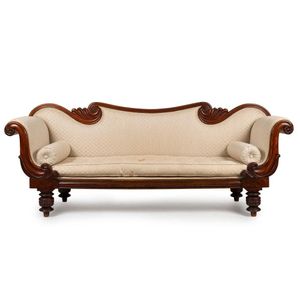
Regency Rosewood Daybed Sofa, c. 1820, Ben Stoner Antiques
Regency simulated rosewood on beech daybed sofa, c. 1820, shaped back and scroll ends carved with acanthus leaves, on down-swept legs with brass castors, bolsters and seat cushion, height 97 cm, width 196 cm, depth 65 cm. Provenance: Ben Stoner Antiques,…

Leppington House Colonial Cedar Sofa, 1830
Leppington House early Colonial Australian cedar sofa, with handsomely carved and turned decoration, and finely upholstered in black horsehair, circa 1830. Nestled at the foothills of the Blue Mountains west of Sydney, Leppington House was a grand two…

Green Velvet Hollywood Regency Curved Sofa by Alan Wanzenberg
Alan Wanzenberg (American), Hollywood Regency curved sofa, green velvet upholstery, on fluted metal legs, with two cushions, height 74 cm, width 205 cm, depth 95 cm. Provenance: Private Collection, Sydney

Regency Cedar Settee from Tasmania, 1835
An early Australian late Regency, William IV double ended settee with carved cedar frame, Tasmanian origin, most likely Launceston, circa 1835-1840. Purchased from Toby & Juliana Hooper in 1983 93 cm high, 230 cm wide, 66 cm deep

Rare Colonial Cedar Sofa with Provenance
Rare Australian Colonial cedar sofa, with shaped back, turned and scrolled arms above shaped Regency style feet. Provenance: Hahndorf region. A similar example is in the Art Gallery of South Australia.

Brass Inlaid Regency Sofa with Cream Velvet Upholstery
Regency mahogany and brass inlaid sofa, c. 1830, with shaped back and scrolled arms decorated with brass inlay in floral and vine motifs, the apron inlaid with brass flowers and scrolls, upholstered in cream velvet with a floral pattern, raised on tapered…

William IV Cedar Settee, Tasmanian Origin
An early Australian late Regency, William IV double ended settee with carved cedar frame, Tasmanian origin, most likely Launceston, circa 1835-1840. Purchased from Toby & Juliana Hooper in 1983, 93 cm high, 230 cm wide, 66 cm deep

Regency Style Caned Sofa with Greek Influence
An Anglo Indian caned sofa, circa 1820 in the early Regency style based on the classical Greek couch, the reeded scrolling end supports centred by patera with a caned seat, raised on ring turned supports 232 cm long, 66 cm deep Literature for a similar…

Regency-style Double Ended Settee in Red Cedar Wood
An Anglo-Indian double ended settee, finely carved red cedar in the Regency manner, circa 1825, 95 cm high, 197 cm wide, 60 cm deep
 Loading more...
Loading more...